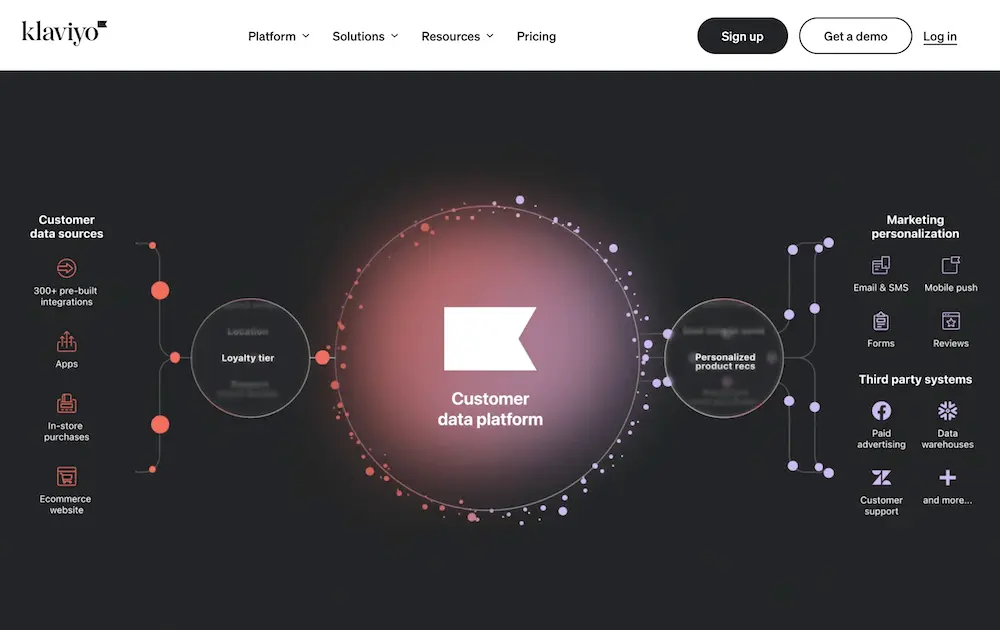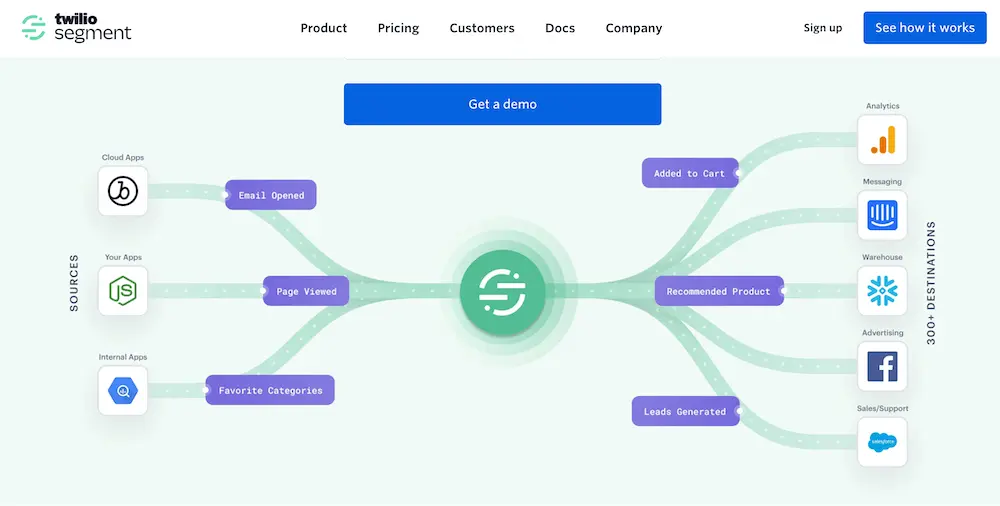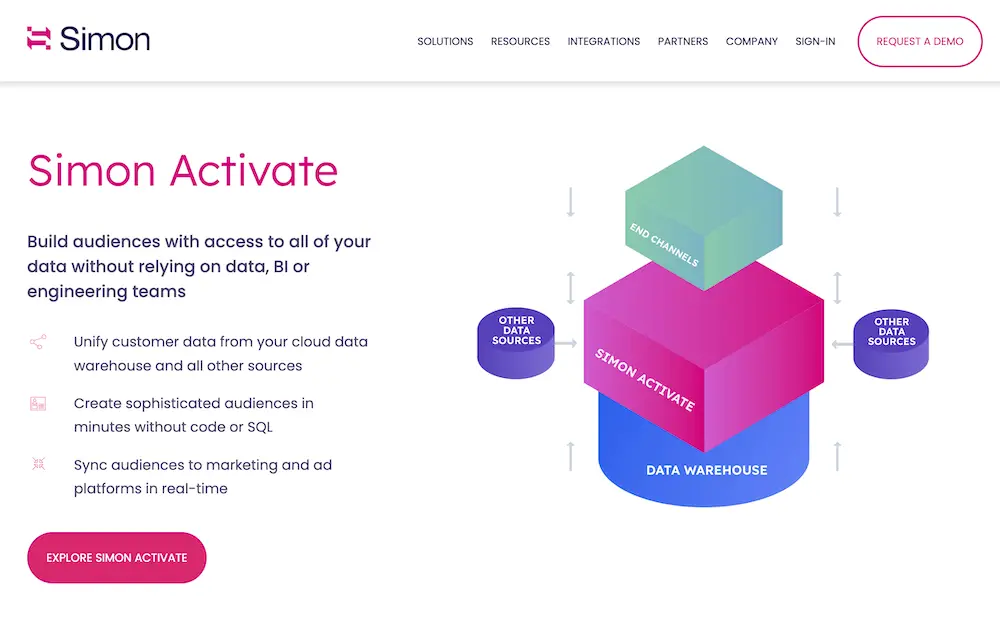The best customer data platform (CDP) speeds up time to value and lowers total cost of ownership. Will yours?

If you’ve landed here on this article, you already know what a CDP is.
It’s a system that collects, unifies, and stores customer data from multiple sources at scale, and makes it available for manipulation and distribution to systems of insight and engagement.
You probably also know that, because a CDP eliminates data silos in the customer database layer of an omnichannel tech stack and serves as the foundation of a personalized marketing strategy, choosing the right CDP for your business is a big deal—and, given the number of options available in the market, it’s easier said than done.
Below is our list of 5 of the top CDPs for centralizing customer insights and making them actionable for highly targeted marketing. It’s not a comprehensive list, and of course we’re a little biased. But we’ve tried to select a list of CDPs that encompasses a wide range of different business sizes and use cases.
Here, we break down why you might want to use each provider—and why you might not.
1. Klaviyo CDP

Klaviyo CDP is a vertically integrated CDP that allows Klaviyo users to more effectively manage and activate their data in Klaviyo. As the first CDP built for businesses of all sizes, it provides user-friendly tools to enrich and transform data, run more advanced reporting and predictive modeling, and sync data in Klaviyo with other systems at scale.
Why you might want to use Klaviyo CDP
- You care about time to value. Klaviyo CDP:
- Is user-friendly, with a self-serve interface accessible to marketers of all technical skills
- Requires minimal additional set-up or custom development
- You’re looking to lower your total cost of ownership. Klaviyo CDP offers:
- Best-in-class vertical integration with marketing automation channels
- Unique ability to store unaggregated, lifetime event data for every customer
- Built-in native data ingestion, manipulation, syncing, activation, and analysis
- Lower software spend, fewer development hours, and less ongoing maintenance
- You want to personalize and segment using all-time data—fast. With Klaviyo CDP, you get granular visibility into your brand’s lifetime of data, from real-time browsing behavior to transaction behavior from years ago, allowing for:
- More advanced analysis and complex personalized customer experiences at scale
- Higher customer lifetime value (CLTV) and retention rates
- Lower acquisition costs
Why you might not want to use Klaviyo CDP
- You have advanced needs around data governance and security, advanced online/offline identity resolution, and consolidating data from multiple regions and accounts. More features in these categories will be available with Klaviyo CDP in 2024.
- You are looking for a standalone CDP solution. Currently, Klaviyo CDP can only be purchased with the Klaviyo marketing application.
2. Segment

According to Twilio, which acquired it in 2020, Segment is a CDP “that helps you collect, clean, and control your customer data. It enables developers to unify customer data from every customer touchpoint, and empowers marketing, sales, and customer service leaders with the insights they need to design and build relevant, data-driven customer engagement.”
Why you might want to use Segment
- You have advanced needs around data governance, transformation, and security.
- You have very advanced needs for identity resolution. Segment offers features such as online/offline identity resolution and configurable, multiple identifiers on the same profile.
- You need the ability to ingest advertising and attribution data from analytics tools.
- You need the ability to store account-level B2B information.
Why you might not want to use Segment
- You need a marketer-friendly CDP that you can get up and running fast. The Segment implementation timeline can be lengthy, with daily meetings, additional required training, extensive data mapping, and a complex user interface demanding a high level of technical expertise to manage day-to-day operations.
- You need indefinite storage for raw event and profile data. Segment aggregates event data stored on a profile after 14 days—meaning real-time, granular access to historical data is not possible.
- You need templates, automations, and data models built specifically for ecommerce use cases. Segment does not offer this.
- You need advanced email and SMS marketing design, orchestration, and testing capabilities, including user-friendly templates and no limits on the number of steps in an automation. Segment does not offer this.
- You need the ability to design and test branded on-site forms natively in-platform. Segment does not offer this.
3. Tealium

Tealium “connects customer data across web, mobile, offline, and IoT so businesses can better connect with their customers,” according to their website. “Tealium’s turnkey integration ecosystem supports more than 1,300 built-in connections, empowering brands to create a complete and real-time customer data infrastructure.”
Why you might want to use Tealium
- You need a CDP that is 100% flexible and customizable. Tealium is 100% customized to your business, offering few out-of-the-box attributes.
- You need a CDP that powers digital transformation across many departments, not just IT and marketing.
- You need a CDP that’s industry- and vendor-agnostic. Tealium will work with competitors if you already use one as part of your tech stack.
- You need a powerful tag system for robust event and data collection.
- You need a CDP that offers native consent management at scale.
Why you might not want to use Tealium
- You need a marketer-friendly CDP that you can get up and running fast. The Tealium implementation timeline can be lengthy, with extensive data mapping and developers required on staff to manage day-to-day operations.
- You need indefinite storage for raw event and profile data. Depending on the context, lookback is difficult or impossible in Tealium, and inactive profiles are purged after 13 months.
- You need the ability to use historical data in audience segmentation. Tealium segments are created with criteria “from this day forward” by default.
- You need templates, automations, and data models built specifically for ecommerce use cases. Tealium does not offer this.
- You need the ability to design, deliver, and test on-site forms, email marketing, and SMS messaging natively in-platform. Tealium does not offer this.
4. Bloomreach Engagement

Bloomreach products include Engagement, a marketing automation platform that also acts as a CDP; Discovery, an ecommerce search solution; and Content, a headless content management system. Together, this technology “personalizes the ecommerce experience” and “unifies real-time customer and product data so businesses understand what customers really want,” according to their website.
Why you might want to use Bloomreach Engagement
- You need a highly internationalized CDP that offers multi-language, multi-brand, multi-region, and consent management.
- You already use Bloomreach Discovery or Content and want to use Bloomreach for more tooling.
- You have advanced needs around rules- and AI-based product recommendation models.
Why you might not want to use Bloomreach Engagement
- You need a marketer-friendly CDP. Setting up Bloomreach data integrations can be complex, designing and testing content and creative can be clunky, and the segmentation and flow builders can be difficult to understand and use.
- You want the option to work with an agency partner on implementation. The Bloomreach partner ecosystem is limited.
- You need a CDP with a robust ecosystem of built-in integrations. The Bloomreach integrations ecosystem is limited.
5. Simon Data

Simon Data “enables brands to deliver incredible customer experiences everywhere,” according to their website. The company claims to help users leverage all of their data at enterprise scale so they can “create powerful personalized experiences effortlessly.”
Why you might want to use Simon Data
- You need a CDP with integrations with advertising platforms such as Twitter.
- You need a CDP with anonymous tracking capabilities. Simon Data partners with FullContact to make deterministic matches by using third-party data and linking anonymous online actions to known users.
- You need a CDP with the ability to run detailed queries with multiple nested conditions, in order to pull granular-level detail.
Why you might not want to use Simon Data
- You need a marketer-friendly CDP that you can get up and running fast. The Simon Data implementation process can be lengthy and complex, with extensive data mapping and technical expertise required to make changes to journey orchestration.
- You need a CDP that enables real-time personalization. Simon Data can take up to 3 hours to refresh.
- You need the ability to design and test on-site forms, email marketing, and SMS marketing natively in-platform. Simon Data technically offers email and SMS, but the functionality is new, and it can be difficult to manage content and creative in-platform.
- You need a CDP with a robust ecosystem of built-in integrations. The Simon Data integrations ecosystem is limited.
- You need flexible data retention limits. With Simon Data, datasets that have not been used, viewed, and updated in the last 30 days are subject to automatic archival.
- You need indefinite storage for raw event and profile data. In Simon Data, the lookback period is limited to 30 days for behavioral events, 90 days for channel events, and 1 year for transactional events.
Want to go beyond CDP selection? We cover everything you need to know to make sure you start from a place of value and end with loyal, lifelong customer relationships in this CDP marketing series. Check out:
- What is a CDP?
- Benefits of a CDP
- CDP marketing use cases
- Questions to consider before selecting the right CDP for your business
Best CDP FAQs
Is it necessary to have a dedicated IT team to implement and manage a CDP software?
The short answer: Historically, yes. But not anymore.
The long answer: Often, due to steep technical learning curves and custom development needs, traditional CDPs are co-owned by marketing and IT or engineering and development teams. But since the ultimate goal of a CDP is to optimize marketing, it’s now possible to find a CDP accessible and user-friendly enough that marketers can use and maintain it on their own—without relying on developers or data scientists.
What types of data can be stored in a CDP?
While a CDP ingests data from anywhere, it’s focused primarily on zero- and first-party data, or data you collect ethically and consensually from your customers. This may include behavioral data, such as information about actions someone has taken on your website or app; transactional data, such as information about someone’s past purchases or returns; and demographic data, such as customer information like name, location, and age.
Can a CDP integrate with third-party marketing tools?
Yes—integration is a big part of a CDP’s job. A CDP collects, unifies, and stores customer data from multiple sources at scale, and makes it available for manipulation and distribution to systems of insight and engagement. Depending on the CDP, these systems may be native or external (bonus points when they’re native). “Systems of engagement” includes tech like your marketing tool.

Related content

Stop wasting time debating attribution models. Learn why traditional attribution is flawed and how Klaviyo’s flexible settings help you measure true marketing impact.

Discover how leading brands use Klaviyo to grow subscription businesses. Learn strategies for upselling, personalization, retention flows, and advanced automations that increase lifetime value and reduce churn.

Migrating to Klaviyo? Get expert insights on timing, tools, and tips to maximize your impact before Black Friday & Cyber Monday.